bridger
Back to VCBS First Page
INSIDE THIS ISSUE:
CAMBRIDGE JUNCTION BRIDGE REPAIR FUNDED! VERMONT COVERED BRIDGE POSTAGE STAMP PROPOSED!
HISTORIC COVERED BRIDGE COMMITTEE SYMPOSIUM! FIRST VCBS ALL-MEMBERS MEETING SLATED!
THE LINCOLN GAP COVERED BRIDGE RENOVATION! FULLER BRIDGE RECONSTRUCTED!
TAX EXEMPT STATUS OF VCBS! NEW COVERED BRIDGE SLATED FOR NORTH HARTLAND!
PAPER MILL COVERED BRIDGE OPENED TO MINI- CEREMONY! TUNBRIDGE CELEBRATES MILL BRIDGE OPENING!
BRIDGE TALK - Go to Index Page VOLUNTEERS WANTED! LETTERS ADS - Covered Bridge Stuff
Press Conference Scheduled
Cambridge, VT - Funding has been found to stabilize the severely damaged Cambridge Junction Covered Bridge.
The money should be received by the Vermont Agency of Transportation in August and will be immediately available to take steps to ensure that the bridge survives the winter.
An estimated $200,000 will be spent on this first phase of the project, probably to install temporary cribbing and construct a Bailey bridge within the wooden structure to support it. There is concern that the bridge could fail totally if there were a heavy snow or additional ice damage.
Although money for the repair of the Cambridge Junction bridge near Jeffersonville was not approved as part of the earmarked federal highway funds that Senator Jeffords originally requested, the senator has been able to have $1 million provided from other appropriations.
The Cambridge Board of Selectman has responded to the grant with a pledge of matching funds.
A press conference is scheduled at the bridge for August 22, 10:30 AM, at which Senator Jeffords will announce the awarding of the funds and will include a presentation of VCBS membership card #1 to the senator by our president in recognition of his efforts to help preserve our covered bridges. This will also be great publicity for the VCBS and anyone who can attend this event will be welcome.
by Kathie Knight, Membership Committee
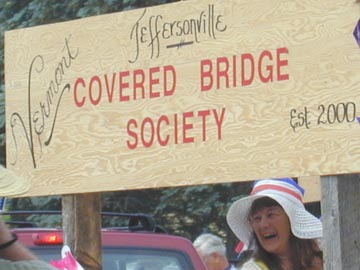 Fellow "Bridgers" picture this: Four to six Vermont covered bridges on a pane of USPS postage
stamps for using, saving and FRAMING! This idea came to me in July and I sent the proposal to
the Citizen's Stamp Advisory Committee (CSA) in Washington, DC for their consideration.
Having worked for the Postal Service for l6 years now, this stamp suggestion approval would
most certainly be a career highlight!
Fellow "Bridgers" picture this: Four to six Vermont covered bridges on a pane of USPS postage
stamps for using, saving and FRAMING! This idea came to me in July and I sent the proposal to
the Citizen's Stamp Advisory Committee (CSA) in Washington, DC for their consideration.
Having worked for the Postal Service for l6 years now, this stamp suggestion approval would
most certainly be a career highlight!The CSA Committee wrote to me last week, telling me "I'd be pleased to know that the idea for a VT Covered Bridge stamp is before the committee for consideration" and that they are in the process of selecting stamps for the year 2003. Cross your fingers! Get those matted frames ready! I have high hopes for this being an acceptable idea as, to my knowledge, there has never been a stamp like this before.
This stamp proposal follows on the heels of the formation of the VT Covered Bridge Society, of which I am a member and assist with mailings of the Membership Committee. This also coincides with the success Sen. James Jeffords has had with his support of the National Historic Preservation Act of October l999, through which he has acquired $l0 million for covered bridge restoration. Sen Jeffords, copied on my stamp proposal, replied with a very nice note of appreciation!
Montpelier, VT - The state's Historic Covered Bridge Committee met August 7 to discuss strategies for preserving our bridges.
Representatives of the VT Agency of Transportation (AOT) and the VT Division of Historic Preservation (DHP) had been "working collaboratively over the past year to develop a preservation plan for covered bridges" and invited a variety of participants to join them to "discuss some of the current issues and problems pertinent to covered bridges."
Participants numbered about 25, with representatives from AOT, the Federal Highway Administration, several construction companies active in restoration and repair work, and five members speaking for the VCBS. These were Joe Nelson, Ed Barna, Bill McKone, Doug Porter, and John Dostal.
The main item for discussion was the difficulty encountered in preserving historic covered bridges when they are frequently allowed to deteriorate until repairs require replacement of most or all of the original bridge. This creates a situation where historic preservation may be better served by removing the existing bridge intact and building a replica as a replacement.
The VCBS was asked to comment on what our organization's policy is regarding preservation, but it was explained that we were not in a position as a new organization to state a defined policy at this time.
We stressed to the group at the meeting that we want to play a positive role in assisting where we are able in the preservation, however it is defined, of historic covered bridges.
There was also discussion of restoration and repair techniques and testing methods to determine beforehand just how extensive repairs might be so that informed decisions could be made about how to proceed.
It was clear that in some cases bridges should be removed intact and this raised the question of what should be done with them. In some situations, the bridge could be used as a feature of a park in the vicinity of its original siting; in others, this may not be appropriate and this again brings up the need for a covered bridge museum where information, artifacts, and even entire bridges could be preserved and displayed.
Efforts are already under way to work toward the creation of such a museum and any input of ideas or assistance from VCBS members would be welcomed and can be provided to the secretary, Bill McKone.
The VCBS was recognized by the other participants in the meeting as being a valuable resource to assist in preserving the historic covered bridges.
One specific way that we can help is to work at the grass roots level to encourage legislation to provide funding dedicated to the routine maintenance of the bridges, as many cases of extensive repairs or even replacement of entire bridges were attributed to the owners not doing basic maintenance on them.
The DHP owns five bridges and commented that it is difficult to get the funds to maintain them properly.
This was a very useful meeting that included many of the people involved in the preservation of these bridges from various standpoints. The main organizer, Sue Scribner, stated at the conclusion of the meeting that there may well be another such symposium to exchange ideas in the future.
Lyndonville, VT - The first All-members Meeting has been slated for the weekend of September 16 and 17 for members and their families and all friends of covered bridges.
The festivities will begin with a get-acquainted gathering on the Sanford Covered Bridge just off Route 5 south of the junction of Route 122. There will be a brief information meeting held by the Board of Directors at that time about the organization's ongoing projects.
A tour of Lyndon's covered bridges will follow, a visit to the Shores Museum, an old-fashioned Vermont Chicken and biscuit supper, a covered bridge slide show and a dance.
On day two, we will explore the covered bridges in Irasburg and North Troy. For details of the plans for the two days, see the schedule in the back of this issue of The Bridger.
Attendees needing hotel/motel accommodations are urged to make their arrangements early; there will be competition for rooms; the foliage season will be beginning, and the local college has will be holding an event.
The meeting was conceived and planned by VCBS members Marge and Francis Converse and the Chairman of the Northeast Kingdom Chapter of the VCBS, Jim Fearon, all of whom are owed a vote of sincere thanks.
by Joe Nelson
Warren, VT, July 5, 2000 - The historic Lincoln Gap Covered Bridge in Warren is undergoing extensive renovation. Built in 1880, the bridge features queenpost trusses of massive dimensions. The truss, long hidden from casual inspection, has been concealed by sheathing these many years.
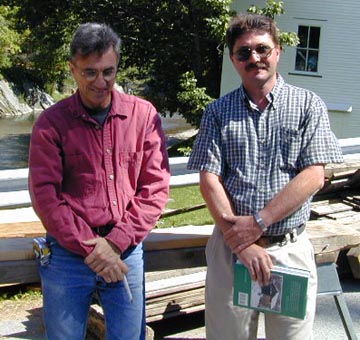 The story of Warren and its
covered bridge experience is of great interest to the covered bridge community. When a town and
its taxpayers have decided to do serious work on their bridge, how is it funded? Who does the
work of the town in finding the funds? Where do you find the expertise to do the
construction?
The story of Warren and its
covered bridge experience is of great interest to the covered bridge community. When a town and
its taxpayers have decided to do serious work on their bridge, how is it funded? Who does the
work of the town in finding the funds? Where do you find the expertise to do the
construction?Jan Lewandoski, owner of Restoration and Traditional Building, won the contract. The company specializes in historic preservation and the structural restoration of historic timber structures.
Lewandoski and his crew have been restoring covered bridges since the mid 1980's They have restored 24 covered bridges including Town lattice, Burr arch, tied arch, kingpost, queenpost, Long and Paddleford types. They have built three new bridges, with single spans as long as 147 ft. (Lowes Bridge, Guilford, Me.) and are presently starting on a fourth, an 80-foot lattice truss, for the Town of Hartland, Vermont.
I met with Jan Lewandoski and Phil Covelli, Assistant Administrator for the Town of Warren to get their stories: about the bridge, the work being done; and about how the town funded the work.
Phil Covelli: "In June '98, the AOT inspected all of the bridges up and down Mad River, and didn't find anything that was too serious with this one. We knew what needed to be done because of the study, but it wasn't closed to traffic at that point. Then the flood came and knocked off one of the fascia boards on the upstream side enabling us to see the beams. When we got a look at those we knew we had problems. That low carrying beam has been rotting away for a [long time].
Joe Nelson: "How do the townspeople feel about the bridge, are they pretty much attached to it?"
P.C.: "We got a lot of support for it. Down stream there is a little waterfall, a man-made dam. The town voted that year, 1998, to put $10,000 into a fund for a reconstruction effort for this and for the dam."
J.N.: "Was that to be matching money for whatever grant you could get?"
P.C.: "Could. For basic maintenance even if we had to cover it ourselves money-wise. No way did we expect the price tag we wound up with, we didn't know there was that much wrong with it. We approached the Agency of Transportation through the bridge and culvert program. It's a program that has a $75,000 cap. The town pays 10 percent. Simultaneously we approached the Preservation Trust of Vermont which is underwritten by a lot of people in Vermont. The Freeman Foundation; we approached them to get some funding for this. This was in the fall of '98, it took until July of '99 just to get those two funding sources together. At that point Jan submitted a bid. Four bidders submitted a bid for the project. Jan had worked on the bridge before. The select persons were comfortable with his bid and his history. There's only a handful of these guys around, so word gets around who's good at it, and who is primarily a concrete bridge contractor.
"Once Jan submitted the bid, the board accepted it. He was ready to get started and he came down here and did further inspection and found out even more was wrong with it than the $75,000 that we had initially talked about.
" So we approached the AOT; Warren Trip and J. B. McCarthy. We proposed that since we were going to fix the bridge, and 75 percent of the work, the scaffolding, lifting the bridge up, what would be the sense in fixing it halfway and then six years later having to come back and lift the bridge back up to do the downstream side. Didn't make much sense. They agreed and the AOT came up with a special agreement were they will pay 95 percent of the cost up to $135,000. And the town would have to pay 5 percent. It gets a little confusing . We have one program, we pay 10 percent, and that $75,000 and the additional $35,000 or so is covered by another program which we pay 5 percent, then we have the Freeman Foundation/Preservation Trust money as well, so we're in good shape. So in total, we're looking at about $107,000 for this project."
J.N.: "Did you have to manage all this?"
P.C.: "The AOT did a lot of this work and Jan did a lot of it, but getting the funding sources together, I brokered that more or less. It worked out well. It's unfortunate we had to wait this long for the bridge to be rebuilt but it was fortuitous that we were able to do it all at one time. The folks at AOT were really supportive of this whole thing. We don't have enough good things to say about these folks. They really came through for us."
Jan Lewandoski: "What we are doing here is mostly rebuilding the upstream truss which over the years had suffered some rot. That rot also occurring at the big windows located between the queen posts. Water running down from there rotted out the bottom part of the queen post and its connection to the bottom chord and rotted right through the bottom chord.
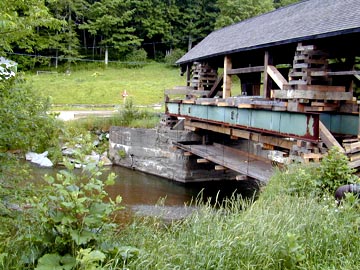 "It had been repaired, I don't
really know when, with a splice across the bad part of the chord. Affixed with bolts and split
rings, [it was] probably done by the state I'm guessing, at least 40 years ago. It was getting worse,
the carrying timbers had rotted and the floor was in danger of sagging, so the town and state
decided to fix that truss of the bridge.
"It had been repaired, I don't
really know when, with a splice across the bad part of the chord. Affixed with bolts and split
rings, [it was] probably done by the state I'm guessing, at least 40 years ago. It was getting worse,
the carrying timbers had rotted and the floor was in danger of sagging, so the town and state
decided to fix that truss of the bridge."When looking at it more, with the state Covered Bridge Committee and emeritus leader Warren Trip, we decided to take the bridge back closer to its original form. Over the course of time more joists and more carrying timbers had been added [to the bridge], and some metal work had been added to the outside of the queen post.
"The original [queen post] connection is a metal connection. One of the things people who look at historic covered bridges get confused about, they think everything was wood on these bridges. Pretty much only the lattice trusses, and Paddleford's truss depend totally on wood connections. With most of the other bridges, the tension connections are metal, even the oldest, the original bridges, the Colossus in Philadelphia of 1811, was filled with metal stuff, Theodore Burr's bridges are full of metal.
" In this bridge the original connection between the queen post and the chord was a wedge-tab dove-tail joint but there were no pins in the dove tail and its angle of slope over 12 inches was about an inch, so it wasn't really going to do any real holding. Two long bolts inside each queen post ran down through it, through the chord, and through the carrying timbers below it.
"At a later date, maybe in the 1930s or 40s, probably when motor vehicle traffic came on the bridge, the state added auxiliary brackets on the side of the queen posts with auxiliary rods, and I think they added more carrying timbers below, 10 x 12s. What we are going back to is probably the original carrying timber situation which was a pair of 12 x 14 timbers, in this case it would be hardwood timbers, oak or hickory, at each queenpost. And we are using bolts the same as the originals in the original positions, still keeping the auxiliary brackets; the state feels they are necessary for modern truck traffic.
"The original tension connection of the queen post and chord on this bridge is an iron bolt, quite common in trusses at the time. You'll find it in churches; bridges aren't the only trusses in the state, the attics of all the churches are filled up with trusses, and many town halls. Some of them quite old, some from the 18th century. Go to the middle ages, and you'd find metal at the bottom of kingpost trusses for tension joinery.
"In the floor in this bridge: we're changing the carrying timbers; we'll have the floor joists out; we're going to replace any bad stringers or those made of built-up lumber with solid 10 x 12 stringers that go from the carrying timbers to the abutments or from carrying timber to carrying timber. And this bridge had been given a nail-lam 2 x4 deck recently. It wasn't in terrible shape but was getting worn. The worse thing about nail-lam in general is that it is un-repairable. You can't take apart a nail-lam deck, you've got to destroy it to do anything, even to inspect the bridge. So we're going over to 3-by plank laid transversely across the bridge, across the stringers, and on top of the 3-by plank, two-and-a half-inch hardwood runner plank lagged down. Hopefully that will keep the vehicles in the center. I doubt if the bridge had runner plank originally, but it probably had 3 or 4 inch transverse plank. It didn't have nail-lam for sure.
" We are repairing the end-posts with scarf repairs in the bottoms, changing the bottom chord and putting on bed timbers which it hasn't had for a long time but it probably originally had; white-oak 10 x 12s with a span of 10 to 12 feet at each abutment, they'll spread load around and are sacrificial: if rot occurs it doesn't rot up into the chord.
[Editor's note: Jan Lewandoski replaced the original upstream chord with an identical member; a 12" x 12" x 56 ft. single stick of white spruce acquired in the Northeast Kingdom, "the largest single stick of natural timber I have ever installed," he said. Since the interview, Lewandoski has found and installed another chord timber into the downstream truss as well.]
by Joe Nelson
Montgomery, VT, July 13, 2000 - The reconstruction of Montgomery's Fuller Bridge is progressing rapidly, to the delight of the townspeople visiting the site. Dismantling began on April 26 and completion of the bridge is slated for August 15, said Marc Cote of Blow and Cote Inc., General Contractors of Morrisville, Vermont. Phil Pierce, consulting engineer, designed the replacement floor system.
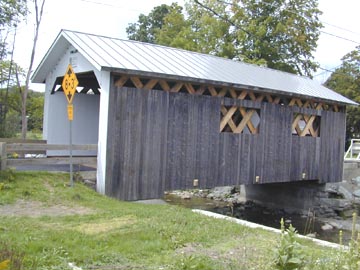 The first truss was started on
June 15 in the Montgomery Town Garage lot and completed in ten days. The second truss was
built on top of the first and completed in six days. Assembly of the end posts into the trusses took
one day each. The first truss was set across the river on Friday, July 8. The second truss followed
on Wednesday, July 12.
The first truss was started on
June 15 in the Montgomery Town Garage lot and completed in ten days. The second truss was
built on top of the first and completed in six days. Assembly of the end posts into the trusses took
one day each. The first truss was set across the river on Friday, July 8. The second truss followed
on Wednesday, July 12.Asked what he found when his team dismantled the bridge, Cote replied: "The upstream truss was hit during the flood with all kinds of debris, wood, trees, whatever. All of the lattices were broken off and the bottom chord on the abutment was rotted right off. That's why they had the beam on the upstream side."[The AOT had installed a steel "I" beam on the deck on the inside of the upstream truss to reenforce the damaged chord pending repairs.]
There is no salvage except for the roof, which was rebuilt after it was torn off in the winter of 1982 by a logging truck.
Eric Gilbertson and the Covered Bridge Committee met at the bridge when the trusses were down, said Cote. "They knew the upstream truss was no good but they wanted to inspect the down stream truss. We found that there were a few salvageable pieces, but they were so few, that it only made sense not to use them because they had rotted where they were touching each other. The rot isn't all the way through the lattice planks, but it's a failed piece of wood so necked down that it didn't make much sense to try to use it.
"The committee was thinking maybe we could use this lattice [plank] and this chord [piece]. I told them that you can't do that because we can't match holes. The holes were in a random pattern, not done with a template. The other thing that was peculiar about this bridge is that the inside lattices were shorter than the outside lattices. That made it so that the squares were not symmetrical, they were a little oblong. We think that's the last bridge that the Jewetts built and they used up all their pieces because all the chord planks were short. There were six, maybe seven chord pieces to go across the bridge and it's only a fifty-foot bridge."
The application for tax exempt status for the VCBS was submitted to the IRS on June 21, 2000. After initial examination by the IRS, some additional documentation was requested by them and provided by the secretary. We have been advised that we meet all the criteria for recognition of an organization as tax exempt and have completed the application process. There should be a determination letter received from the IRS in August documenting our tax exempt status. The Employer Identification Number that has been assigned to the organization will be made available to any contributors needing it for tax purposes when claiming a donation to the VCBS.
Man bites dog! A steel and concrete bridge is to be replaced by a wooden covered bridge instead of the other way around! Jan Lewandoski of Restoration and Traditional Building is the contractor.
Two bridges cross the Ottauquechee River at the North Hartland Dam, mainland to island, island to mainland. The concrete bridge is failing, but the Willard Covered Bridge is in great shape, said Jan Lewandoski. "The Willard Bridge, better than most, it's taller, 16 feet from the bottom of the bottom to the top of the top, it has positive camber, it's about 118 feet long."
Two covered bridges served the causeway until a hurricane took one of the bridges out in 1938. "They replaced it with a concrete bridge," said covered bridge restorer Lewandoski. "The concrete bridge is ruinous now, whereas the wooden bridge is in great condition, so it's an example of how a covered wooden bridge will last and how poorly concrete has done in this century.
"The town has decided they want to put a wooden bridge back in there, and the State went along with that. And because one wooden bridge already exists, there is no point in making the other wooden bridge any wider or taller than that one, so I didn't have to build 24 feet of roadway or something like that, just 17 feet of roadway like the existing one has. It does you no good to get into the one bridge if you can't get through the other one.
"It will be a tall and big truss, 88 feet. I'll start on it in mid July. We'll be building it in a park in town. It won't go over the river until next spring though, because the abutment contract was let separately."
North Bennington, VT, July 13, 2000 - "The ceremony lasted a whole ten minutes," said David Guay.
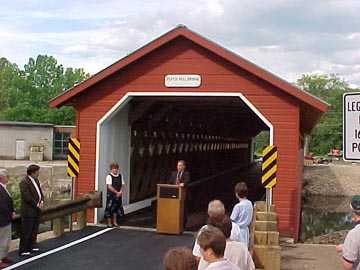 For Guay the turnout for the
official grand opening of the replica covered bridge was not a fitting finish to a project he had
been following since last February. Winter, spring, and summer, he has recorded every stage of
construction with his digital camera, sharing his photos with the Vermontbridges dot
Com web page and with his friends.
For Guay the turnout for the
official grand opening of the replica covered bridge was not a fitting finish to a project he had
been following since last February. Winter, spring, and summer, he has recorded every stage of
construction with his digital camera, sharing his photos with the Vermontbridges dot
Com web page and with his friends.To commemorate the building of the bridge, he has donated copies of his digital images to the Vermont Covered Bridge Society on floppy disk, and he is assembling a booklet showing the step by step construction.
Guay wrote to the editor of the Bennington Banner: "Sir, I was at the Grand Opening Ceremony of the Paper Mill Covered Bridge in Bennington on 7/13/00. I feel that the coverage of your paper was lacking. The event deserved better coverage than it was accorded.
"The article 'Dean, Officials open restored bridges' gave very minimal coverage to the New Paper Mill Covered Bridge. There was no historical information about the bridge, circumstances of its building, who built it. The covered bridges of Bennington are a valuable resource to the tourism industry of the area, and as much information as possible should have been given to this event.
"On 7/3/00 the new Mill Covered Bridge in Tunbridge, VT was pulled across the First Branch of the White River. The town of Tunbridge treated this as a MAJOR EVENT. There were thousands of people there to witness this historical event. There were vendors selling their wares, and many community organizations had booths set up to promote the new covered bridge as well as Tunbridge as a whole. This whole event had a carnival feeling to it. Why didn't Bennington even attempt to do anything along these lines. In all, 35 people attended the Paper Mill Covered Bridge Dedication.
"In my opinion, Bennington missed a GOLDEN OPPORTUNITY to promote the covered bridges of the area, and to show that the covered bridges of the area are a viable tourism tool. Bennington clearly dropped the ball on this one."
David Guay, whose handle is "Bridgeman," is a member of the New York State Covered Bridge Society and of the Vermont Covered Bridge Society. He can be found at almost any covered bridge site doing his thing.
Tunbridge, VT - On July 22, 2000 Tunbridge celebrated the opening of a new covered bridge in the heart of the village's historic district. Friends of the old Mill Covered Bridge gathered for the ribbon cutting and a bit of pageantry. Euclid Farnham, author and Tunbridge Historian served as Master of Ceremonies while Dick Ellis' South Royalton Band provided the music.
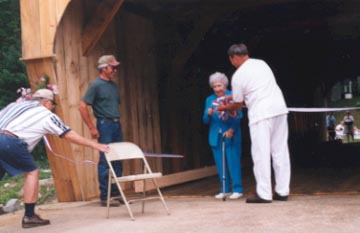 Alona Litwick, at 92 the town's
eldest resident, cut the ribbon, officially opening the bridge. Alona also rode in the first
automobile to officially cross the bridge, a vintage Chevelle convertible.
Alona Litwick, at 92 the town's
eldest resident, cut the ribbon, officially opening the bridge. Alona also rode in the first
automobile to officially cross the bridge, a vintage Chevelle convertible.The celebration continued with Euclid Farnham telling the story of the coachman notorious for running bridges, Shane Young, playing the part of the coachman, droves his rig through the bridge at a trot. Dan Mullen, Tunbridge First Constable, stepped forward to enforce the edict of the Selectmen: "ONE DOLLAR FINE for a person to drive a horse or other beast faster than a walk or drive more than one loaded team at the sam time ON THIS BRIDGE."
"Here is two dollars," retorted the coachman. "'Cause when I come back this way, I'm going to run your ding bridge again!" Or words to that effect. And according to history, he did. Mounted color guard Lorri Berger walked her horse through the new bridge followed by Scott Guth leading his ox Jackson through the bridge that they had helped pull over the river last July 3.
The celebration concluded with a parade of four pre-1940 vintage cars passing over the bridge.
The story behind the celebration began March 5, 1999, when after a two day struggle to bring in equipment to rescue it, the Mill Bridge was destroyed by river ice. On July 3, just sixteen months after the loss, the new bridge sat ready on rollers. A four-sheave block and tackle attached to the bridge was stretched across the river between a pair of steel girders to the far shore, the hauling line made fast to a windlass, or sweep, with several turns around its barrel.
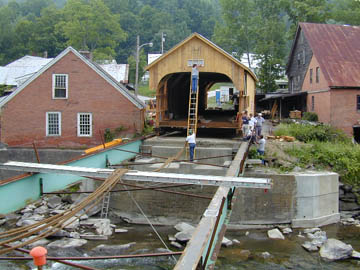 One last chore and all would be
ready; a crewman climbed to the gable-end to install the recently restored sign "One Dollar Fine . .
. ."
One last chore and all would be
ready; a crewman climbed to the gable-end to install the recently restored sign "One Dollar Fine . .
. ."At 9 a.m. Tom Mullen brought his team of oxen, Buckshot and Shorty to the sweep and began the circular journey. Three other teams of oxen took their turns as the bridge was inched across the stream. Contractor Neil Daniels worked with his crewman as they made adjustments and measured progress. The bridge's designer, consulting engineer Phil Pierce, watched from the crowd of onlookers. Five hours and twelve minutes later, after many stops and starts, screeches, groans, and one startling bang! The bridge is in place.
The new structure is probably the fifth to span this place. Photographic evidence from the 1870's indicates that an open bridge served here before it was replaced by the bridge recently lost to ice. The house at the west approach has changed but little in outward appearance from those early years. The brick building beside the bridge was a blacksmith shop first established in 1791. The first bridge at the site was built in 1797 and destroyed by flood the following year. The replacement bridge served until 1815 and was followed by a third.
The fourth bridge, according to Euclid Farnham, was built by Arthur Adams in 1883 at a cost of $523.32. The timbers were prepared at the sawmill housed in the brick and frame building that still stands next to the bridge site. The new bridge, Built by Neil Daniels Construction of Ascutney, Vermont, cost $230,000. [Editor's note: Readers have likely noticed the misspelled word on the new sign over the bridge portal. The sign and its spelling is a faithful copy of the original.]
Newsletter Editor
Requirements: warm body and computer with e-mail address. If you have WordPerfect, it's a plus but not a requirement.
Duties: Collect stories, edit, and compose the quarterly issues of The Bridger.
Staff writer:
Requirements: warm body and computer with e-mail address.
Duties: Write feature articles, assist Editor in collection of stories and rewrite as
needed.
Correspondents:
Duties: Collect covered bridge items and stories from their home areas or
travels, and send them to the editor.
Candidates please contact Joe Nelson, 2 Sugar Hill Road, Underhill, VT 05489, or to jcnelson@together.net]

I also collect post cards of Vermont Covered Bridges - I have around 200 right now. I am more interested in the older post cards and very interested in finding post cards of Vt. covered bridges that no longer exist. I enjoy finding a post card of a covered bridge no longer standing and finding the actual spot it originated. This summer I was in New Hampshire photographing their covered bridges when I came upon the Clarks Bridge in Lincoln, NH - the minute I saw it I recognized it as the Covered Railroad Bridge that used to exist in Barre/Montpelier, Vt. & was torn down. I was able to make this discovery from the old post card I have of the Covered Railroad Bridge when it existed in Vermont. I could go on and on with volumes of stories.
I was raised in West Rupert, Vt. and when married moved to the township of Granville, NY which is a NY/VT border town. Until recently I still owned property in Vermont. While I may be a "New Yorker" I am still a "Vermonter" at heart! Good luck with the formation of the Covered Bridge Society. I am looking forward to keeping up with news from Vt. Covered Bridges and meeting people who share the same passion.
Sandra Ritchie, PO Box 50, Middle Granville, NY 12849
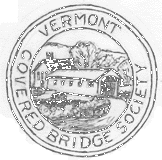 A
VCBS patch designed by member Francis Converse of Lyndonville
A
VCBS patch designed by member Francis Converse of LyndonvilleWatch this space - ads coming
Joe Nelson, P.O Box 267, Jericho, VT 05465-0267, jcnelson@together.net
No part of this web site may be reproduced without the written permission of Joseph C.
Nelson
Text Copyright © 2000, Joseph C. Nelson
Photographs Copyright ©, 2000, Joseph C. Nelson
This file updated August 25, 2000